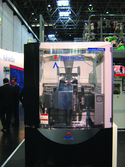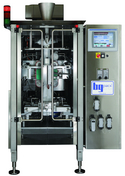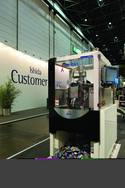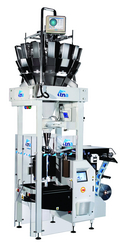Feeling the heat
15 November 2011With another wave of innovation this year, ultrasonic sealing seems to be coming of age, but is it grown up enough to take on heat sealing? Lynda Searby finds out
This year’s Interpack and PPMA shows saw a flush of form, fill, seal (FFS) machines with ultrasonic sealing. Italian manufacturer PFM demonstrated its top-of-range Vetta VFFS machine equipped for the first time with ultrasonic sealing, and Düsseldorf was the first outing for Ishida Europe’s Ultrasonic Atlas bagmaker for the snacks industry.
These are by no means the first FFS machines to market with ultrasonic technology.
Bosch Packaging Technology, as Dr Bernd Wilke, director technology support, points out, “discovered this technology at a very early stage for our vertical machine portfolio and has been present in the market since 2007.”
Ilapak has been offering its packaging machines with ultrasonic sealing for the last six years. “We identified it quite early on as being an important technology that we could lead with,” says managing director Guy Levy.
Another early adopter – Paramount Packaging Systems, whose main target market is pharmaceuticals and medical devices – launched its ultrasonic FFS system at the last Interpack in 2008.
However, most in the industry agree that packers and processors have only recently started to warm to ultrasonics.
“We were probably ahead of the market when we first introduced ultrasonics and not all of our customers were quite ready for it,” concedes Ilapak’s Levy. “Now customers are getting used to the idea and more and more are benefiting from our ultrasonic technology.”
Ultrasonics explained
Ultrasonic technology uses acoustics (mechanical sound waves) to create a molecular bond between plastics materials. The film is sealed with heat from friction generated by an oscillating tool, eliminating the need for direct heat contact.
“Unlike conventional heat sealing in which heat is applied to the outside of the film, ultrasonic technology generates the heat for the sealing process from within the film,” explains Chris Bolton, sales and operations director with PFM Packaging Machinery.
Removal of the heating element has several benefits: it enables ‘cold’ sealing of sensitive products, such as delicate confectionery, grated cheese, fresh produce and frozen food. It also means less energy is used, making ultrasonic sealing ‘greener’ than heatsealing.
Ishida Europe estimates that energy consumption is reduced by up to 70% when making the back seal, and 33% on the end seal, owing to the lower electrical power requirement.
Another advantage of ultrasonic versus heat sealing is the film savings that can be made, as the seals at the longitudinal and transverse seams are narrower, so less packaging material is required.
“The sealing depth is reduced by up to 85% – from typically 13mm to just 2mm, which will save you up to 11% in film usage, or 385m of film on an average film roll,” says Torsten Giese, marketing manager with Ishida Europe.
Seal integrity
While these benefits all contribute to the case for ultrasonic sealing, at present the overriding reason packagers and processors are moving to ultrasonic is because of the seal integrity it offers – ultrasonic can seal through most product residues which may have accidentally been deposited in the seal area.
It follows, therefore, that PFM is targeting the ultrasonic option on its Vetta bagging machine at applications in which seal integrity is difficult to achieve reliably due to risk of contamination in the seal area. “Frozen food, wet and dusty products are all examples,” says Bolton.
Ilapak reports that the sectors showing the most interest in ultrasonic sealing are salad leaves, grated cheese and confectionery. It’s no coincidence that these are all vertical rather than horizontal applications.
“When dropping product through the heat seal jaws there is always the potential for product to fall late or early, get caught in the jaws and create a leaking pack; this still can happen with ultrasonic jaws but the risk of leakers is dramatically reduced as a result of ultrasonic technology,” explains Ilapak’s Levy. “On a horizontal machine, the risk of product getting between the jaws is lower, therefore leaking seals as a result of product in the seal are less of a problem.”
On the face of it, therefore, there is less incentive for users of horizontal flow wrappers to pay extra for ultrasonic sealing. That said, as Levy points out, mounting pressure on packers and processors to use simpler films, on both cost and environmental grounds, could soon provide the impetus to get the horizontal market moving.
Finding favour in pharma
One area that is embracing ultrasonic technology for flow wrap applications is pharmaceutical and medical devices, according to Paramount Packaging Systems, distributor of a flow wrapper with ultrasonic sealing from Fuji Machinery Co.
The company’s Aaron Bessell says: “We have found that many people are interested in the system due to its benefits, which include ease of validating the sealing process, the smaller seals produced, cold sealers and lower power usage.”
The system produces hermetic seals on multi-layer laminate materials used for modified atmosphere packaging in the pharmaceutical sector and the heavier gauge mono-layer films used for medical devices. It is said to cut through contamination such as water.
Putting up resistance
Many suppliers are now adopting ultrasonic sealing, but it is important to note that it hasn’t found a supporter in every supplier.
Redpack Packaging Machinery is adamant that it has no intention of getting involved with ultrasonic sealing. And TNA Packaging Solutions says: “At present we have no plans to develop an ultrasonic solution.” Shayne De la Force, TNA group marketing manager, explains: “Ultrasonic sealing is highly sensitive to film structure and width, requires 100% precision in setup, so is not considered user-friendly.”
Another sticking point is the slower speeds that he says go hand in hand with ultrasonic sealing. “Current ultrasonic technology is restricted to use with flat jaws, which operate at only half the speed of the rotary jaws TNA Solutions are equipped with. Rotary jaws have scope for double, or even triple jaw action, with distinct speed advantages.”
Tackling teething problems
Ishida Europe admits that ultrasonics is still a technology in development, and is working to address teething problems.
“Ishida Japan is working hard on the precision control and speed,” says Giese. “We can already confirm that bagging speeds of up to 160 packs per minute can be reached – at Interpack it was up to 140 bags per minute.”
Speed might be an issue for high volume users like some snack and confectionery companies, but not so for other sectors. “There is a misconception that ultrasonic sealing is slow,” says Ilapak’s Levy. “Actual seal speed can be faster than heat sealing.”
For him, the capital outlay has historically been more likely to slow the take-up. “We’re not talking about a 10% or 20% premium – it’s been more than that. So only certain companies have been able to afford to invest in it,” he says. “Because it’s a relatively new technology, the economies of scale are just now starting to kick in and are starting to make ultrasonic technology much more attractive to invest in.”
Ishida Europe agrees that cost is a major barrier to the development of the market. “We’ve had a very high level of interest in our technology, but a very low enquiry level as the technology is still too expensive, even with the apparent benefits,” says Torsten Giese.
Beyond ultrasonics
It’s not surprising, therefore, that equipment manufacturers are choosing not to put all their eggs in the ultrasonic basket, and are focusing on other areas of R&D.
Ishida, for example, says it is concentrating on improving the energy efficiency of its bagmakers. To this end it has designed ECO displays for its Atlas machines. These enable users to monitor and reduce energy consumption by confirming how much power is being used at any given time, providing real-time data on product and film waste, and prompting the use of an energy-saving mode when appropriate.
One of PFM’s key areas of development has been to obtain higher speeds for bagging machines aimed at specific growth areas in the European food market.
The first fruits of this programme were seen last year with the introduction of the Supernova modified atmosphere bagging machine, said to be the fastest MAP bagger available and to open the shelf life advantages of MAP economically to a wider range of high volume food products.
“Continued growth in extended shelf life products throughout Europe has driven demand for faster and more productive machinery,” explains PFM’s Bolton. “Our response has been to lift the speed of our MAP bagging equipment by more than 40% compared with our previous top model.”
Capable of producing MAP packs at speeds of up to 250/min, the Supernova is aimed at high volume food products such as cheese, pasta, snacks and bakery items.
Fuji, meanwhile, has ‘further pushed’ the design of its wrappers with a machine that runs faster, incorporates a film scanner, and has a redesigned HMI interface – as well as offering reduced power consumption.
The scan unit can check all packs are produced in the correct materials to match the product and customer, and that all statutory information is correctly printed.
Launched at this year’s PPMA, the Alpha 7 range was initially developed for the pharmaceutical industry, but Paramount believes it will be taken up by companies in other sectors that need to ensure their products meet supermarket demands.
It is unlikely ultrasonic will overtake heat as the FFS sealing technique of choice any time soon, owing to its limitations and cost. However, once it begins to win the confidence of the big players and economies of scale start to kick in, it will become a no-brainer for applications where seal integrity is paramount.
The Atlas bagmaker targets the snacks industry Ishida Ishida’s Atlas ultrasonic bagmaker was first launched at Interpack Atlas 2 PFM has equipped its Vetta machines with ultrasonics Vetta The Robag 3c from TNA Robag Rotary jaws on the TNA Robag TNA






